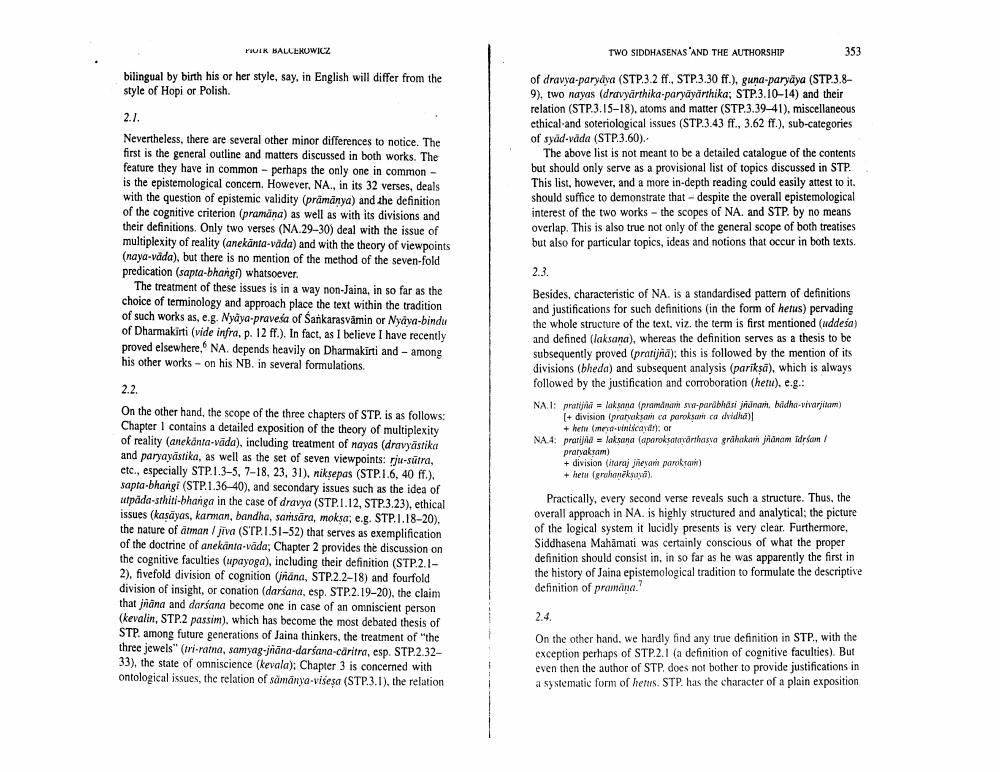Book Title: Two Siddhasenas And Authorship Of Nyayavatara And Sammati Tarka Pprakarana Author(s): Piotr Balcerowicz Publisher: Piotr Balcerowicz View full book textPage 2
________________ PUIK BALCEROWICZ TWO SIDDHASENAS AND THE AUTHORSHIP 353 bilingual by birth his or her style, say, in English will differ from the style of Hopi or Polish. 2.1. Nevertheless, there are several other minor differences to notice. The first is the general outline and matters discussed in both works. The feature they have in common - perhaps the only one in commonis the epistemological concern. However, NA., in its 32 verses, deals with the question of epistemic validity (pramanya) and the definition of the cognitive criterion (pramana) as well as with its divisions and their definitions. Only two verses (NA.29-30) deal with the issue of multiplexity of reality (anekānta-vdda) and with the theory of viewpoints (naya-vada), but there is no mention of the method of the seven-fold predication (sapta-bhangi) whatsoever. The treatment of these issues is in a way non-Jaina, in so far as the choice of terminology and approach place the text within the tradition of such works as, e.g. Nyaya-praveśa of Sankarasvamin or Nyaya-bindu of Dharmakirti (vide infra, p. 12 ff.). In fact, as I believe I have recently proved elsewhere, NA, depends heavily on Dharmakirti and - among his other works - on his NB. in several formulations. of dravya-paryava (STP.3.2 ff., STP.3.30 ff.), guna-paryāya (STP.3.89). two nayas (dravyārthika-paryāyarthika; STP.3.10-14) and their relation (STP.3.15-18), atoms and matter (STP.3.39-41), miscellaneous ethical and soteriological issues (STP.3.43 ff., 3.62 ff.), sub-categories of syad-vīda (STP.3.60). The above list is not meant to be a detailed catalogue of the contents but should only serve as a provisional list of topics discussed in STP. This list, however, and a more in-depth reading could easily attest to it. should suffice to demonstrate that - despite the overall epistemological interest of the two works - the scopes of NA. and STP. by no means overlap. This is also true not only of the general scope of both treatises but also for particular topics, ideas and notions that occur in both texts. 2.3. 2.2. On the other hand, the scope of the three chapters of STP. is as follows: Chapter 1 contains a detailed exposition of the theory of multiplexity of reality (anekanta-vāda), including treatment of rayas (dravyästika and paryayāstika, as well as the set of seven viewpoints: rju-sútra, etc., especially STP.1.3-5, 7-18, 23, 31), niksepas (STP.1.6. 40 ff.). sapta-bhangi (STP.1.36-40), and secondary issues such as the idea of utpäda-sthiti-bhanga in the case of dravya (STP.1.12, STP.3.23), ethical issues (kasayas, karman, bandha, sarisära, moksa; e.g. STP.1.18-20). the nature of atman/jiva (STP.1.51-52) that serves as exemplification of the doctrine of anekanta-vāda, Chapter 2 provides the discussion on the cognitive faculties (upayoga), including their definition (STP.2.12), fivefold division of cognition (ñana, STP.2.2-18) and fourfold division of insight, or conation (darsana, esp. STP.2.19-20). the claim that jäna and darsana become one in case of an omniscient person (kevalin, STP.2 passim), which has become the most debated thesis of STP. among future generations of Jaina thinkers, the treatment of the three jewels" (tri-ratna, samyag-frāna-darsana-caritra, esp. STP.2.3233), the state of omniscience (kevala): Chapter 3 is concerned with ontological issues, the relation of sámánya-visesa (STP.3.1), the relation Besides, characteristic of NA. is a standardised pattern of definitions and justifications for such definitions in the form of hetus) pervading the whole structure of the text. viz. the term is first mentioned (uddesa) and defined (laksana), whereas the definition serves as a thesis to be subsequently proved (pratijna), this is followed by the mention of its divisions (bheda) and subsequent analysis (pariksā), which is always followed by the justification and corroboration (heru). e.g.: NAT: pratijii = laksana (praminam sv-paribhasi jricinani bidha-vivarjitam) (+ division (pravaksan sa poroksar ca uvidha) + het (megoviniscard!), or NA4: prariji laksana (aparoksatmárthasva grāhakari janam Idrsom / pratsaksam) + division (itaraj jesam paroksa) + heru (grahanēksuvi). Practically, every second verse reveals such a structure. Thus, the overall approach in NA. is highly structured and analytical, the picture of the logical system it lucidly presents is very clear. Furthermore, Siddhasena Mahāmati was certainly conscious of what the proper definition should consist in, in so far as he was apparently the first in the history of Jaina epistemological tradition to formulate the descriptive definition of pramana. 2.4. On the other hand, we hardly find any true definition in STP, with the exception perhaps of STP.2.1 (a definition of cognitive faculties). But even then the author of STP. does not bother to provide justifications in a systematic form of hetus. STP. has the character of a plain expositionPage Navigation
1 2 3 4 5 6 7 8 9 10 11 12 13 14
